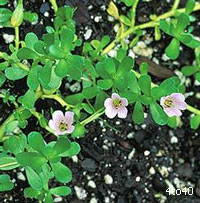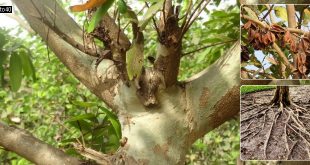Bacopa Monniera (Herpestis Monnieria, Thyme Leaved Gratiola, Brahmi) — Family Name: Scrophulariaceae
Botanical Name: Bacopa Monniera
Common Name: Herpestis Monnieria, Thyme Leaved Gratiola, Brahmi
Part Used: Whole Plant
Habitat: Grows in Marshy places and cultivated South India.
Uses: It is Diuretic, Cardiac, Nervine and Tonic. It is reported to improve intellect, treatment of asthma, hoarseness, insanity, epilepsy. It is a potent nervous tonic and is anti anxiety agent. It is considered good for heart.
Introduction
 Bacopa monniera is bitter in taste; has been used in the Ayurvedic system of medicine for centuries. Brahmi which occurs naturally in India and has a long history of use in the Ayurvedic medicine tradition in the treatment of a number of disorders, particularly those involving anxiety, intellect and poor memory. Traditionally, it was used as a brain tonic to enhance memory development, learning, and concentration.
Bacopa monniera is bitter in taste; has been used in the Ayurvedic system of medicine for centuries. Brahmi which occurs naturally in India and has a long history of use in the Ayurvedic medicine tradition in the treatment of a number of disorders, particularly those involving anxiety, intellect and poor memory. Traditionally, it was used as a brain tonic to enhance memory development, learning, and concentration.
Plant Description
Bacopa monniera, is a small, creeping herb with numerous branches, succulent, rooting at the nodes, with numerous prostrate branches, each 10-30 cm long. Brahmi leaves are petiole, oblong, sessile, and fleshy. Flowers are purple in color; axillary, solitary with peduncles. In India and the tropics it grows naturally in wet soil, shallow water, and marshes. The herb can be found at elevations from sea level to altitudes of 4,400 feet, and is easily cultivated if adequate water is available. Flowers and fruit appear in summer and the entire plant is used medicinally.
Active Constituents and Pharmacokinetics
Compounds responsible for the pharmacological effects of Bacopa include alkaloids, saponins, and sterols. Many alkaloids like Brahmine and herpestine, saponins d-mannitol and hersaponin, acid A, and monnierin–were isolated in India over 40 years ago. Other active constituents identified include betulic acid, stigmastarol, beta-sitosterol, as well as numerous bacosides and bacopasaponins. The constituents responsible for Bacopa’s cognitive effects are bacosides A and B.
Mechanisms of Action
The triterpenoid saponins and their bacosides are responsible for Bacopa’s ability to enhance nerve impulse transmission. The bacosides aid in repair of damaged neurons by enhancing kinase activity, neuronal synthesis, and restoration of synaptic activity, and ultimately nerve impulse transmission.
Loss of cholinergic neuronal activity in the hippocampus is the primary feature of Alzheimer’s disease. Based on animal study results, bacosides appear to have antioxidant activity in the hippocampus, frontal cortex, and striatum. Animal research has shown Bacopa extracts modulate the expression of certain enzymes involved in generation and scavenging of reactive oxygen species in the brain.
History
Brahmi is a popular Ayurvedic herb. It is a herb with an ancient history and has been a revered household name in India for over 3000 years. According to Ayurvedic Text Brahmi is known as a most powerful brain food.
Benefits of using Brahmi:
- In India the plant is used for all sorts of skin problems- eczema, psoriasis, abscess, ulcerations- it is said to stimulate the growth of skin, hair and nails.
- Brahmi is effective against diseases like bronchitis, asthma, hoarseness, arthritis, rheumatism, backache, constipation, hair loss, fevers, digestive problems etc.
- Brahmi is useful for improving mental clarity, confidence and memory recall. For these uses of Brahmi, it has been widely used by students.
- Brahmi is useful in case of nervous deficit due to injury and stroke and nervous exhaustion.
- As Brahmi is bitter in flavor, in India the plant is used in salads, soups, as a cooked lea vegetable, or pickled.
- Indian research has shown that Brahmi has Antioxidant, Cardiotonic and Anticancer properties.
 Kids Portal For Parents India Kids Network
Kids Portal For Parents India Kids Network





